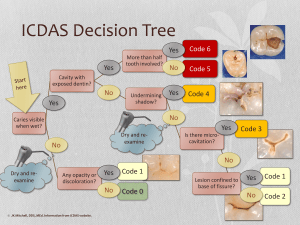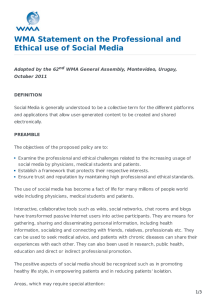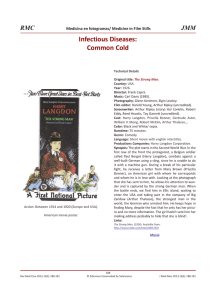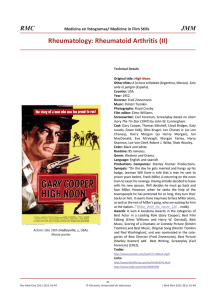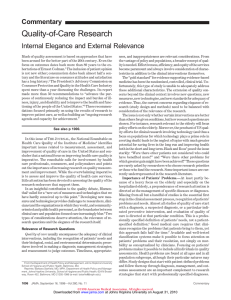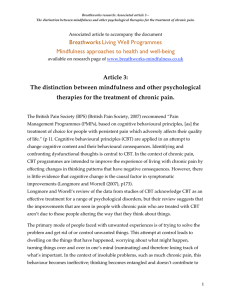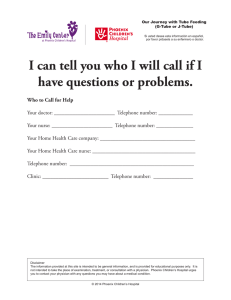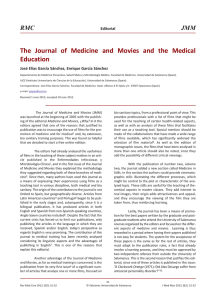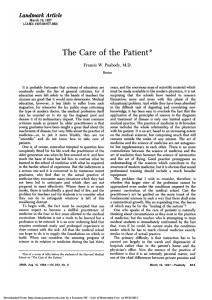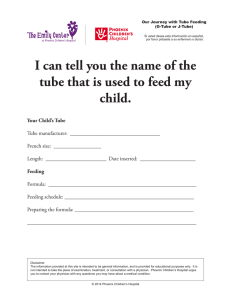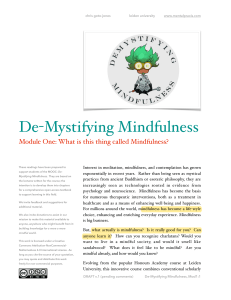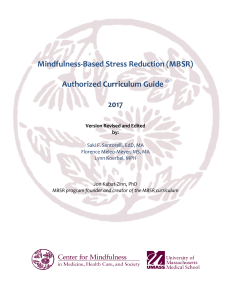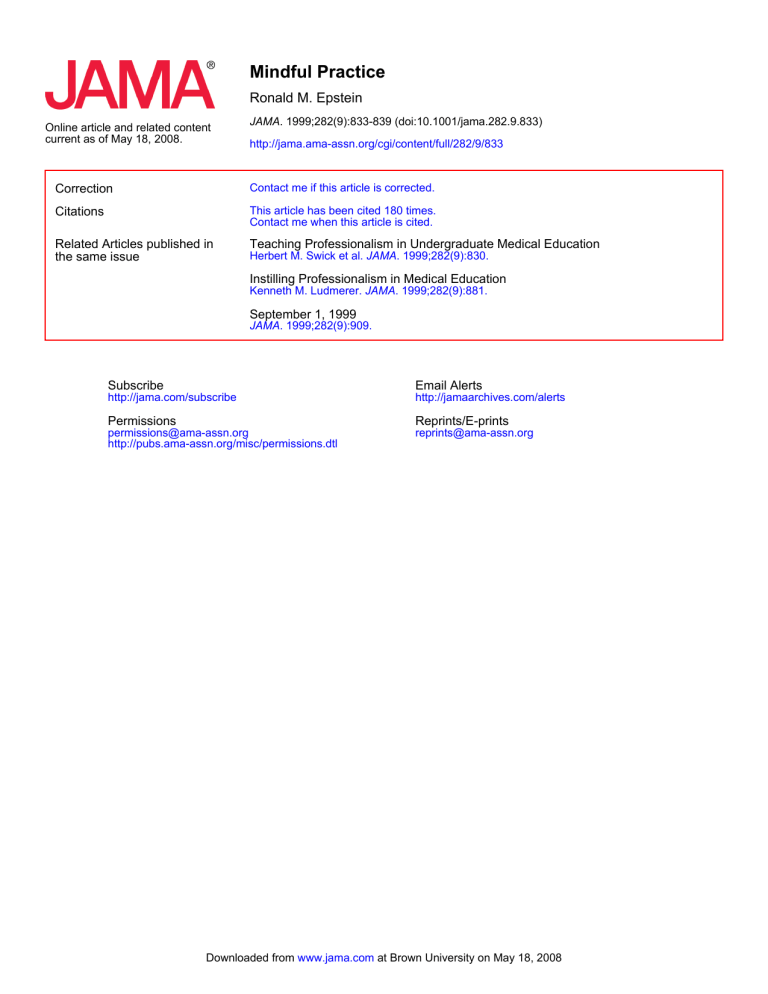
Mindful Practice Ronald M. Epstein Online article and related content current as of May 18, 2008. JAMA. 1999;282(9):833-839 (doi:10.1001/jama.282.9.833) http://jama.ama-assn.org/cgi/content/full/282/9/833 Correction Contact me if this article is corrected. Citations This article has been cited 180 times. Contact me when this article is cited. Related Articles published in the same issue Teaching Professionalism in Undergraduate Medical Education Herbert M. Swick et al. JAMA. 1999;282(9):830. Instilling Professionalism in Medical Education Kenneth M. Ludmerer. JAMA. 1999;282(9):881. September 1, 1999 JAMA. 1999;282(9):909. Subscribe Email Alerts http://jama.com/subscribe http://jamaarchives.com/alerts Permissions Reprints/E-prints [email protected] http://pubs.ama-assn.org/misc/permissions.dtl [email protected] Downloaded from www.jama.com at Brown University on May 18, 2008 SPECIAL COMMUNICATION Mindful Practice Ronald M. Epstein, MD R EFLECTION AND SELF-AWARE- ness help physicians to examine belief systems and values, deal with strong feelings, make difficult decisions, and resolve interpersonal conflict.1,2 Organized activities to foster self-awareness are part of many family medicine residency programs3 and some other residency4,5 and medical school curricula. 5-8 Exemplary physicians seem to have a capacity for critical self-reflection that pervades all aspects of practice, including being present with the patient,9 solving problems, eliciting and transmitting information, making evidencebased decisions, performing technical skills, and defining their own values.10 This process of critical self-reflection depends on the presence of mindfulness. A mindful practitioner attends, in a nonjudgmental way, to his or her own physical and mental processes during ordinary everyday tasks to act with clarity and insight.11-15 This article first describes the nature of professional knowledge, competence, and values and then presents current thinking about the philosophical, psychological, and practical aspects of mindfulness. It also explores how mindfulness is integral to the professional competence of physicians and suggests ways to cultivate mindfulness in medical training. In doing so, however, I recognize that mindful practice, although supported by empiric observation of clinical practice,16-21 educational research,22-26 philosophy,11,27 and cognitive science,11,28-30 is fundamentally personal and subjective. See also pp 830 and 881. Mindful practitioners attend in a nonjudgmental way to their own physical and mental processes during ordinary, everyday tasks. This critical selfreflection enables physicians to listen attentively to patients’ distress, recognize their own errors, refine their technical skills, make evidence-based decisions, and clarify their values so that they can act with compassion, technical competence, presence, and insight. Mindfulness informs all types of professionally relevant knowledge, including propositional facts, personal experiences, processes, and know-how, each of which may be tacit or explicit. Explicit knowledge is readily taught, accessible to awareness, quantifiable and easily translated into evidence-based guidelines. Tacit knowledge is usually learned during observation and practice, includes prior experiences, theories-in-action, and deeply held values, and is usually applied more inductively. Mindful practitioners use a variety of means to enhance their ability to engage in moment-to-moment self-monitoring, bring to consciousness their tacit personal knowledge and deeply held values, use peripheral vision and subsidiary awareness to become aware of new information and perspectives, and adopt curiosity in both ordinary and novel situations. In contrast, mindlessness may account for some deviations from professionalism and errors in judgment and technique. Although mindfulness cannot be taught explicitly, it can be modeled by mentors and cultivated in learners. As a link between relationship-centered care and evidence-based medicine, mindfulness should be considered a characteristic of good clinical practice. www.jama.com JAMA. 1999;282:833-839 Consider a situation that I recently faced with a patient who required an expanded view of professional knowledge and mindful reflection to achieve a satisfactory resolution. A 42-year-old mother of 2 small girls, despondent over job difficulties, was contemplating genetic screening for breast cancer as she approached the age at which her mother was diagnosed as having the same disease. Aside from the difficulties in taking an evidence-based approach to assigning quantitative risks and benefits to the genetic screening procedure (How much should I trust the available information?) and uncertainty about the effectiveness of medical or surgical interventions (Would knowing the results make a difference, and, if so, to whom?), the case raised important relationship- ©1999 American Medical Association. All rights reserved. centered questions about values (What risks are worth taking?), the patientphysician relationship (What approach would be most helpful to the patient?), pragmatics (Is the geneticist competent and respectful?), and capacity (To what extent is the patient’s desire for testing biased by her fears, depression, or incomplete understanding of the illness and tests?). For me, book knowledge and clinical experience were insufficient. I had to rely on my personal knowledge of the Author Affiliations: Departments of Family Medicine and Psychiatry, University of Rochester School of Medicine and Dentistry, Rochester, New York. Corresponding Author and Reprints: Ronald M. Epstein, MD, Department of Family Medicine, University of Rochester School of Medicine and Dentistry, 885 S Ave, Rochester, NY 14620 (e-mail: [email protected]). JAMA, September 1, 1999—Vol 282, No. 9 Downloaded from www.jama.com at Brown University on May 18, 2008 833 MINDFUL PRACTICE Table 1. Professionally Relevant Awareness and Knowledge Levels of Awareness Tacit (subsidiary awareness) Explicit (focal awareness) Types of Knowledge Propositional Personal Process (including metaprocessing) Know-how patient (Is she responding to this situation in a way concordant with her previous actions and values?) and myself (What values and biases affect the way I frame this situation for myself and for the patient?) to help us arrive at a mutual decision. These reflective activities applied equally to the technical aspects of medicine (How do I know I can trust the interpretations of medical tests?) and the affective domain (How well can I tolerate uncertainty and risk?). An attitude of critical curiosity,31 openness, and connection17,32,33 allowed us to defer the decision and reconsider testing once the immediate crises had passed. Explicit and Tacit Knowledge Clinical judgment is based on both explicit and tacit knowledge.34-36 Medical decision making, however, is often presented only as the conscious application to the patient’s problem of explicitly defined rules and objectively verifiable data.34,37,38 This form of explicit knowledge can be quantified, modeled, readily communicated, and easily translated into evidence-based clinical practice guidelines. Seasoned practitioners also apply to their practice a large body of knowledge, skills, values, and experiences that are not explicitly stated by or known to them.34 This knowledge may constitute a different kind of evidence, which also has a strong influence on medical decisions. In everyday life, examples of tacit knowledge abound. Riding a bicycle involves judgments about speed, orientation, and position that are rarely made conscious except when something goes amiss. Similarly, an experienced neurologist can recognize Parkinson dis834 JAMA, September 1, 1999—Vol 282, No. 9 ease within moments of meeting a patient, before processing the objective and subjective data to support it. During this preattentive processing,39 the brain rapidly scans a wide array of perceptions, detects conspicuous features, and relegates some information to the background, all before the content of the perception is analyzed. Clinical skills, such as the depth of insertion of an otoscope, the manipulation of the fetal head during a delivery, and the realization that the patient has given sufficient information to diagnose major depression involve tacit knowledge and preattentive processing. While explicit elements of practice are taught formally, tacit elements are usually learned during observation and practice.40 Often, excellent clinicians are less able to articulate what they do than others who observe them. Nor do they appreciate all of the biases in their own reasoning processes.41 Subsidiary awareness35 is a term that describes how the practitioner makes accessible the flow of unprocessed experience and tacit knowledge. In the words of Anaïs Nin, “We don’t see things as they are, we see things as we are.”42 Evidence-based medicine offers a structure for analyzing medical decision making, but it is not sufficient to describe the more tacit process of expert clinical judgment.43 All data, regardless of their completeness or accuracy, are interpreted by the clinician to make sense of them and apply them to clinical practice.44 Experts take into account messy details, such as context, cost, convenience, and the values of the patient.36,43,45,46 Physician factors such as emotions,47 bias,48 prejudice,49 risk-aversion,50-53 tolerance for uncertainty,54,55 and personal knowledge of the patient also influence clinical judgment. 50-55 Most of the processes described above remain relatively unconscious to the practitioner. Clinical judgment is a science and an art.36 Even those who are uncomfortable with the notion of tacit knowledge recognize that it is impossible to make explicit all aspects of professional competence.43 Evidence-based decision models are very powerful tools, but clinicians do not always use them, especially in complex situations.30,56 Information necessary to construct explicit models is frequently incomplete or conflicting. Some important tacit knowledge about the patient, such as personality, simply does not fit into predefined categories. To clinicians, these models may resemble computergenerated symphonies in the style of Mozart—correct but lifeless. Professional Knowledge and Self-awareness Eraut57,58 defines 4 types of professionally relevant knowledge, each of which can be tacit or explicit (TABLE 1). The most familiar is propositional knowledge, or what most people call fact: theories, concepts, and principles, usually acquired from books, electronic media, or instructors. Self-awareness of what one does not know and the appreciation for the transient nature of facts can direct ongoing learning. Knowledge acquired through experience, or personal knowledge, is a collection of information, intuitions, and interpretations that guides professional practice.35 Consider the following example. Returning from vacation, I saw one of my patients who was infected with human immunodeficiency virus and said to the resident caring for him, “Mr Charles looks worse. Looks like he might have adrenal insufficiency.” The personal knowledge exemplified in this scenario differs from an anecdote because it is contextualized. I can say that Mr Charles looks worse because I know him as a person, not just because I know about him, and because I recognize a pattern of disease (weakness and skin color change). This knowledge enters into my mind in an inductive, impressionistic way, providing the gestalt or feel of a clinical situation in addition to the propositional facts.29 However, confusion between personal knowledge and anecdotal information results in both being neglected and discounted during medical training. An example of the uncritical application of a decontextualized anecdote is when a physician who after ©1999 American Medical Association. All rights reserved. Downloaded from www.jama.com at Brown University on May 18, 2008 MINDFUL PRACTICE missing a diagnosis of colon cancer, subsequently overtests all of his patients. In contrast, if he had raised tacit personal knowledge to awareness, it could have been subjected to critical reflection. Process knowledge is knowing how to accomplish a task,59 such as gathering information, performing procedures, making decisions, and planning for the future.58 Process knowledge also includes metaprocessing, or the process of reflection on one’s own mental processes. This is particularly important in practice, because “we do not observe nature as much as we observe nature exposed to our method of questioning.”60 Metaprocessing might be called thinking about thinking or feeling about feelings. It is both a concrete action (such as the modification in a trajectory of light in a mirror) and an act of self-observation in which the mind attends to its own actions (including the subject who is performing those actions). Metaprocessing allows the physician to uncover areas of unconscious incompetence,61 the blind spots wherein a physician might not know his or her deficiencies. Fortunately, clinicians can often readily identify these blind spots and gain insight into the influence of the observer, for example, when they review their own videotaped patient visits.62,63 Eraut’s fourth type of professionally relevant knowledge, know-how, is knowing how to get things done. A resident working in a new setting may know that a diagnostic test is important, but may not know that the test will happen sooner with a friendly call to the radiologist. Learning the steps necessary for getting something done is important in professional development of physicians, but it is often relegated to the informal64 or hidden24,26 curriculum. Mindful Practice Mindfulness is a logical extension of the concept of reflective practice.4,12,14 The mindful practitioner is present in everyday experience, in all of its manifestations, including actions, thoughts, sensations, images, interpretations, and emotions.12,13,65 Mindfulness “leads the mind back from theories, attitudes and abstractions . . . to the situation of experience itself,”11 which prevents us from “falling prey to our own prejudices, opinions, projections, expectations” and enables us to free ourselves from the “straightjacket of unconsciousness.”66 Mindfulness is attending to the ordinary, the obvious, and the present. Johann Sebastian Bach is reported to have said, when asked how he found melodies: “The problem is not finding them, it’s—when getting up in the morning and out of bed—not stepping on them.”67 Although mindfulness is a practice that derives from a philosophical-religious tradition,12,14,15 the underlying philosophy is fundamentally pragmatic13 and is based on the interdependence of action, cognition, memory, and emotion. These connections represent a relatively new idea in neuroscience research.28,68 Western approaches to the understanding of mental processes have historically separated mental activity from action in the world, and the schism between behavioral and psychodynamic psychology has reinforced some of this separation. However, in the East.11,14 and in phenomenological traditions in the West,27 philosophy has linked cognition to emotion, memory, and action in the world. The goals of mindful practice are to become more aware of one’s own mental processes, listen more attentively, become flexible, and recognize bias and judgments, and thereby act with principles and compassion (TABLE 2). Mindful practice involves a sense of “unfinishedness,” 3 1 curiosity about the unknown and humility in having an imperfect understanding of another’s suffering. Mindfulness is the opposite of multitasking. Mindfulness is a quality of the physician as person, without boundaries between technical, cognitive, emotional, and spiritual aspects of practice. Mindful practitioners have an ability to observe the observed while observing the observer in the consulting room. This process, not often discussed in medical practice, is considered essential to musicians, whose task is to perform and listen at the same time, ©1999 American Medical Association. All rights reserved. Table 2. Characteristics of Mindful Practice Active observation of oneself, the patient, and the problem Peripheral vision Preattentive processing Critical curiosity Courage to see the world as it is rather than as one would have it be Willingness to examine and set aside categories and prejudices Adoption of a beginner’s mind Humility to tolerate awareness of one’s areas of incompetence Connection between the knower and the known Compassion based on insight Presence attending simultaneously to the technical challenges, emotional expression, and overall theoretical structure of the music.69 The accomplished musician performs midcourse corrections of finger movements, compares the sound produced with the imagined sound, and, at the same time, brings expressive spontaneity to the performance. However, if the musician were to attempt to control each finger movement while simultaneously analyzing the harmonic structures, rhythms, and silences that constitute expressive playing, playing would become impossible. Thus, focal awareness on the music is accompanied by subsidiary awareness35 of technique and analysis—a mix of peripheral vision and semiautomatic action that is highlighted only when the unexpected or difficult occurs. In medicine, consider what a resident in a busy pediatric emergency department might do when he is unable to determine whether an ear examination is normal or abnormal and the attending physician is not immediately available. The resident has several options, consideration of which could be conscious or unconscious. The resident weighs the consequences of misdiagnosis for the patient, the humiliation of having to call an otolaryngology resident out of the clinic, the loss of selfesteem by having to admit incompetence, and the pride in being strong enough to admit his need to learn. An unmindful practitioner who is conscious of the dilemma might judge or blame himself or others. He might base JAMA, September 1, 1999—Vol 282, No. 9 Downloaded from www.jama.com at Brown University on May 18, 2008 835 MINDFUL PRACTICE his course of action on an external standard of correctness or on expedience. However, little would be learned, and he would be no better prepared for the next situation. A mindful conscious approach would be to cultivate awareness not only of the correct course of action but also of the factors that cloud the decisionmaking process. The mindful practitioner is mentally and technically better prepared for the next situation. The object of mindfulness can apply to any aspect of medical practice and within any domain of tacit or explicit knowledge. Intrapersonal self-awareness helps the physician be conscious of his or her strengths, limitations, and sources of professional satisfaction. It helps the individual avoid blind spots, such as a physician who, because his or her parent was an alcoholic, avoids discussions of alcohol with patients. It may clarify deeply held values and motivations for becoming a physician. Interpersonal self-awareness, or social intelligence,70,71 allows physicians to see themselves as they are seen by others and helps to establish satisfactory interpersonal relationships with colleagues, patients, and students. Awareness of metaprocessing allows physicians to be aware of their own clinical reasoning, including the necessary connections between cognition, memory, and emotional processing.28 Self-awareness of learning needs allows physicians to recognize areas of unconscious incompetence and to develop a means to achieving their learning goals.61 Ethical selfawareness is the moment-to-moment cognizance of values that are shaping medical encounters. Technical selfawareness is necessary for self-correction during procedures such as the physical examination, surgery, computer operations, and communication. Often reflection is prompted by a critical incident involving an error, a difficult situation, or an unexpected result of one’s actions.25,72,73 At other times, reflection is prompted by the maturing of an idea rather than by a discrete external event. However, many of these events go unnoticed by all but the most creative thinkers. The discoveries of peni836 JAMA, September 1, 1999—Vol 282, No. 9 cillin, radiation, and the benzene ring were not accidents, but rather the result of someone making what had been considered an outlier (a tainted Petri dish) into data (a useful medication). Mindfulness enables the practitioner to use a wider set of perceptual resources. The fluidity of mind that can maintain some constant subthreshold awareness of preattentive and subsidiary processes has been described as a “beginner’s mind.”12 A beginner’s mind is open and allows for new diagnostic and therapeutic possibilities, as may happen when a patient meets a new physician. By contrast, the expert’s mind narrows possibilities, using prior experience to delimit and confine observations. Langer13 describes mindfulness as a state of “could be,” welcoming uncertainty rather than trying to avoid it. Difficult patients might then become interesting patients; unsolvable problems might become avenues for research. Critical curiosity shows the limits of categories and helps create more meaningful ones. For example, the recognition of panic disorder as a common cause of chest pain might help physicians recategorize these patients from symptom amplifiers74 to patients with a serious and treatable illness. Expertise is often well served by beginner’s mind, especially in new, unfamiliar, or stressful situations. Mindfulness implies examining the relationship between the knower and the known as suggested in the “I-Thou” relationship of Martin Buber75 or the “connected knowing” of ideas, people or things, suggested by Belenky and colleagues.33 Knowledge, then, does not exist independently but rather in relationship to the one observing and using it. Theories are seen as fragile approximations rather than reality itself.76 Suchman and Matthews17 have described this as the connexional dimension of medical practice, in which there is a tacit bond between patient and physician that transcends professional roles. Mindlessness: Gaps Between Knowledge, Values, and Actions Physicians make moment-to-moment value-laden decisions that entail cog- nitive and emotional factors. They decide how much effort to expend in pursuit of knowledge, how much pain medication to prescribe, how much time to spend with each patient, and when to return patients’ telephone calls. These rapid decisions, usually based on personal knowledge, level of skill, efficiency, and values, ultimately result in actions. Thus, objectives for the practice of medicine calling on physicians should include the ability to perform or knowledge about important aspects of medical care77 as well as the requirement to actually use those practices in daily work. Self-knowledge is essential to the expression of core values in medicine, such as empathy, compassion, and altruism. To be empathic, I must witness and understand the patient’s suffering and my reactions to the patient’s suffering to distinguish the patient’s experience from my own. Then I can communicate my understanding and be compassionate, to use my presence to relieve suffering and to put the patient’s interests first. Perhaps lack of self-awareness is why physicians more often espouse these values than demonstrate them78-81 and why they tend to be less patient-centered82 and confuse their own perspectives with those of the patient1,80 in situations that involve conflict and strong emotions. Curiosity is central both to caring about the patient and to solving problems.83 Fitzgerald16 describes a trainee who reported a patient as having had a history of “BKA” (below-the-knee amputation) without noting that the patient, in fact, had both feet. A transcriptionist had mistranscribed DKA (diabetic ketoacidosis) and the assertion went unchallenged. The student’s lack of curiosity, or overconcreteness, led to mistaking the chart for the patient. Similarly, caring requires an interest in the patient as a person rather than as an abstraction of disease.84,85 For example, Stetten18 described how his physicians were uninterested in his adaptation to blindness while they attempted to treat his macular degeneration; they saw the disease but not the person. ©1999 American Medical Association. All rights reserved. Downloaded from www.jama.com at Brown University on May 18, 2008 MINDFUL PRACTICE Mindlessness accounts for many deviations from professionalism, which seem to occur more often in emotionally charged situations, during situations of uncertainty, and under pressure to resolve problems. For example, many medical students and residents, and presumably practitioners as well, report findings that were not observed and do not seek correction for errors.20 Actions diverge from professional knowledge and values because of attempts to be efficient, a desire to please supervisors, feelings of embarrassment, and a sense of being overwhelmed.2,19,21,82,86,87 Practitioners may not think to apply knowledge gained in a classroom context (such as an ethics course) in a stressful clinical environment. Deviations often involve avoidance of difficult issues, rationalization, externalization, or frank denial rather than the healthy processing of emotional feelings toward patients.88,89 riosity and reflection are required to generate hypotheses and important questions, physicians at this level ignore personal knowledge, tacit knowledge, and emotions. Level 3 includes curiosity about feelings, thoughts, and behaviors without attempting to suppress or label them as good or bad. By including emotions and personal knowledge, the clinician has more tools available to promote patient care. Level 4, insight, has 3 facets: understanding the nature of the problem, understanding how one attempts to solve it, and understanding the interconnectedness between the practitioner and the knowledge that he or she possesses.15 Insight facilitates the calibration of mental processes, in addition to correction of the external problem. Finally, practitioners at level 5 can use their insight to generalize, overcome similar challenges in the future, incorporate new behaviors and attitudes, express compassion, and be present. Levels of Mindful Practice To guide physicians’ professional development, I would like to propose 5 levels of mindfulness, each of which subsumes the previous level and is subject to verification in future observational studies (TABLE 3). At the extreme of mindless practice, the practitioner’s response is denial (level 0). By making the problem “out there,” the practitioner may avoid responsibility and reflection or describe the situation (or the patient) in ways that are contrary to the evidence. Level 1 describes practitioners who do not necessarily use reflection but take some responsibility for the situation and solve it by conforming to an external standard of behavior. For example, a practitioner might deal with his attraction to a patient by reciting a rule, such as “sexual intimacy with patients is wrong,” but may not seek understanding of the factors that put physicians at risk for misconduct.86 Level 2 describes medical decision analysis based on the assumption that explicit cognitive models guide physician behavior and the key to change is the transfer of information. While cu- Becoming Mindful Recent articles1,5,90 have described a variety of ways for becoming more selfaware. Individually, practitioners might keep a journal, practice meditation, review videotapes of sessions with their patients, and use learning contracts. In medical education, self-evaluation forms for students and residents have been important adjuncts to the evaluation process. Learners can compare their perceptions with those of a teacher or mentor. Peer evaluations have been useful in bringing awareness to aspects of professionalism and social skills for students, residents, and practicing physicians.91,92 Critical incident reports written by practitioners about mistakes,20,93 impairment,94 ethical dilemmas,95 and difficult situations can be discussed in small group settings and raise awareness about common situations and one’s reactions to them. Sharing of family information and cultural background, using genograms or illness narratives, can help practitioners learn about the expectations, biases, strengths, and tendencies that influence clinical care.96-99 These approaches, historically focused ©1999 American Medical Association. All rights reserved. Table 3. Levels of Mindfulness Levels Characteristics 0 1 2 3 4 5 Denial and externalization Imitation: behavioral modeling Curiosity: cognitive understanding Curiosity: emotions and attitudes Insight Generalization, incorporation, and presence on the emotional aspects of medical practice and the patient-physician relationship, usually consist of exercises separated in space and time from actual clinical practice. Mindfulness training goes one step further. It applies to all aspects of practice, from looking up references to performing physical examinations, from tying sutures to giving bad news. Mindfulness can link evidencebased and relationship-centered care and help to overcome the limitations of both approaches.37,43,100 The success of evidence-based approaches depends on the ability of the practitioner to decide which issues require further investigation and how to frame a question. These, in turn, require that the practitioner identify his or her own biases and the influences of the patient-physician relationship on framing of the question to investigate. This personal knowledge should also be considered a form of evidence and could be integrateded into decision making to incorporate patients’ preferences. Evidence-based data that are not specific to one patient-physician relationship would then be applied in a more mindful way. Seminars about difficult topics such as HIV management, delivery of bad news, medical mistakes, professionalism, and adherence to treatment can foster reflection and raise practitioners’ awareness of their own emotions and biases, while, at the same time, attending to the practicalities of the patient’s problem.101,102 However, the ability to reflect in a classroom environment is not equivalent to reflection in a stressful clinical environment. For example, ethics courses might increase students’ knowledge base and improve their ability to solve difficult problems, but ethics courses do not necessarily produce physicians whose beJAMA, September 1, 1999—Vol 282, No. 9 Downloaded from www.jama.com at Brown University on May 18, 2008 837 MINDFUL PRACTICE havior is more ethical than it would be otherwise. Clinician-mentors can help students put ideas into action by modeling a moment-to-moment awareness of their own knowledge and emotions that inform their decisions when values are on the line. Professionals can learn to articulate their personal knowledge by observing their own actions (How do I respond to uncertainty? How do I present risks? How do I selfcorrect when doing a difficult technical procedure?) Professional knowledge is defined, then, not by its validity, but by how it is used.23 There is an inherent paradox in teaching or writing about mindfulness. The teacher’s task is to invoke a state of mindfulness in the learner, and, thus, the teacher can only act as a guide, not a transmitter of knowledge. In a recent example of a resident about to face a dreaded follow-up visit with an angry patient who thought that earlier treatment of his hepatitis C might have prevented his end-stage cirrhosis, the mentor’s role was complex. He had to help the resident identify his feelings of guilt and defensiveness that might interfere with communicating effectively with the patient, determine the risks and benefits of liver transplantation, and explore the patient’s wishes regarding end-of-life care. The mentor’s approach was to help the resident identify how he psychologically prepares for each visit with a patient, a “centering” process that had been previously tacit, which usually is not explicit for most practitioners, and to use it more effectively. The mentor helped the resident observe himself, effecting a transition from unconscious incompetence to critical reflection and allowing him to come to a satisfactory decision with the patient based on both objectiveevidenceandpersonalknowledge. Barriers to mindfulness are numerous inmedicaltraining, even in reformed curricula. Fatigue, dogmatism, and an emphasis on behavior (rather than on consciousness)103 close the mind to ideas and feelings. Unexamined negative emotions lead to emotional distance and arrogance. McWhinney identified 3 additional barriers:unexaminednegativeemotions,fail838 JAMA, September 1, 1999—Vol 282, No. 9 ureofimagination,andliteral-mindedness (I.R.McWhinney,MD,oralpresentation, London, Ontario, October 6, 1995). Failureofimaginationlimitsthecuriositythat is the first step in any process of inquiry. Concrete literal mindedness may serve simple diagnostic processes well, but impedes creative problem solving and limitsthephysician’sviewofthepatient.Lack of opportunities to learn how to become mindfulinpracticeandthelackofforums to deal with fears and anxieties create furtherbarriers.Finally,somecliniciansmay fear that mindfulness is the same as excessive self-absorption that would delay necessary clinical actions. They would need to be educated that navel-gazing is antitheticaltomindfulpractice,whichhas as its goal clarity and attention to the tasks at hand. Conclusions Mindfulness, critical reflection, learning, and patient care all “begin with the self as the first, but not the only, object of knowledge.”104 Mindful practice extends beyond examining the affective domains and involves critical reflection on action, tacit personal knowledge, and values in all realms of clinical practice, teaching, and research. Mindfulness is a discipline and an attitude of mind. It requires critical informed curiosity and courage to see the world as it is rather than how one would have it be. Mindful practitioners tolerate making conscious their previously unconscious actions and errors. The goal of mindfulness is compassionate informed action in the world, to use a wide array of data, make correct decisions, understand the patient, and relieve suffering. Mindful practice requires mentoring and guidance. Recognition of one’s limitations and areas of incompetence can be emotionally difficult and can invite avoidance in even highly motivated practitioners. Although mindfulness is an individual and subjective process, each of us can identify practitioners who embody these attributes, learn from them, and identify unique ways of being self-aware. Educators can take on the task of help- ing trainees become more mindful by explicitly modeling their means for cultivating awareness. Funding/Support: Dr Epstein received support from the Robert Wood Johnson Foundation Generalist Physician Faculty Scholars Program and the Fulbright Foundation. Acknowledgment: The ideas in this article were generated during a seminar at the Institute for Health Studies, Barcelona, Spain, and also borrows generously from conversations with Jeffrey Draisin, MD, Pieter LeRoux, PhD, Larry Mauksch, CSW, Maria Nolla, MD, Dennis Novack, MD. I would like to thank Arthur Frank, PhD, Cindy Haq, MD, and Ian McWhinney, MD, for their comments on early drafts of this article, and to the JAMA reviewers whose suggestions were extraordinarily thoughtful and helpful. REFERENCES 1. Novack DH, Suchman AL, Clark W, Epstein RM, Najberg E, Kaplan C. Calibrating the physician. JAMA. 1997;278:502-509. 2. Balint M. The Doctor, His Patient and the Illness. London, England: Pitman; 1964. 3. Brock CD, Stock RD. A survey of Balint group activities in US family practice residency programs. Fam Med. 1990;22:33-37. 4. Hewson MGA. Reflection in clinical teaching: an analysis of reflection-on-action and its implications for staffing residents. Med Teach. 1991;13:227. 5. Novack DH, Kaplan C, Epstein RM, et al. Personal awareness and professional growth: a proposed curriculum. Med Encounter. 1997;13:2-7. 6. Novack DH, Volk G, Drossman DA, Lipkin M Jr. Medical interviewing and interpersonal skills teaching in US medical schools: progress, problems, and promise. JAMA. 1993;269:2101-2105. 7. Novack DH, Dube C, Goldstein MG. Teaching medical interviewing. Arch Intern Med. 1992;152:18141820. 8. Makoul G, Curry RH, Novack DH. The future of medical school courses in professional skills and perspectives. Acad Med. 1998;73:48-51. 9. McPhee SJ. The practice of presence. Presented at: Alpha Omega Alpha Honor Society Spring Lecture; April 17, 1981; Piscataway, NJ. 10. Westberg J, Jason H, Fostering reflection and selfassessment. Fam Med. 1994:26;278-282. 11. Varela FJ, Thompson E, Rosch E. The Embodied Mind: Cognitive Science and Human Experience. Cambridge, Mass: Massachusetts Institute of Technology Press; 1991. 12. Suzuki S. Zen Mind, Beginner’s Mind. New York, NY: Weatherhill; 1980. 13. Langer EJ. Mindfulness. Reading, Mass: AddisonWesley Publishing Co Inc; 1989. 14. Streng FJ. Emptiness: A Study in Religious Meaning. Nashville, Tenn: Abingdon Press; 1967. 15. Nhat Hahn T. Peace Is Every Step: The Path of Mindfulness in Everyday Life. New York, NY: Bantam Books; 1992. 16. Fitzgerald FT. Curiosity. Ann Intern Med. 1999; 130:70-72. 17. Suchman AL, Matthews DA. What makes the patient-doctor relationship therapeutic? [published correction appears in Ann Intern Med. 1988;109:173]. Ann Intern Med. 1988;108:125-130. 18. Stetten D Jr. Coping with blindness. N Engl J Med. 1981;305:458- 460. 19. Christakis DA, Feudtner C. Ethics in a short white coat. Acad Med. 1993;68:249-254. 20. Christensen JF, Levinson W, Dunn PM. The heart of darkness. J Gen Intern Med. 1992;7:424-431. 21. Dimsdale JE. Delays and slips in medical diagnosis. Perspect Biol Med. 1984;27:213-220. 22. Coles C. Approaching professional develop- ©1999 American Medical Association. All rights reserved. Downloaded from www.jama.com at Brown University on May 18, 2008 MINDFUL PRACTICE ment. J Contin Educ Health Prof. 1996;16:152-158. 23. Eraut M. Developing Professional Knowledge and Competence. London, England: Falmer Press; 1994. 24. Hafferty FW, Franks R. The hidden curriculum, ethics teaching, and the structure of medical education. Acad Med. 1994;69:861-871. 25. Schon DA. The Reflective Practitioner. New York, NY: Basic Books; 1983. 26. Wear D. Professional development of medical students: problems and promises. Acad Med. 1997;72: 1056-1062. 27. Baron RJ. An introduction to medical phenomenology. Ann Intern Med. 1985;103:606-611. 28. Damasio AR. Descartes’ Error: Emotion, Reason, and the Human Brain. New York, NY: GP Putnam’s Sons; 1994. 29. Peters RM. The role of intuitive thinking in the diagnostic process. Arch Fam Med. 1995;4:939-941. 30. Wartofsky M. Clinical judgment, expert programs, and cognitive style: a counter-essay in the logic of diagnoses. J Med Philosophy. 1986;11:81-82. 31. Friere P. Pedagogy of Freedom. New York, NY: Rowman & Littlefield; 1998. 32. Matthews DA, Suchman AL, Branch WT Jr. Making “connexions.” Ann Intern Med. 1993;118:973-977. 33. Belenky MF, Clinchy McVicker B, Goldberger NR, Tarule JM. Women’s Ways of Knowing: The Development of Self, Voice, and Mind. New York, NY: Basic Books; 1997. 34. Goldman GM. The tacit dimension of clinical judgment. Yale J Biol Med. 1990;63:47-61. 35. Polanyi M. Personal Knowledge: Towards a PostCritical Philosophy. Chicago, Ill: University of Chicago Press; 1974. 36. Feinstein AR. “Clinical Judgment” revisited: the distraction of quantitative models. Ann Intern Med. 1994;120:799-805. 37. Sackett DL. Evidence-Based Medicine: How to Practice and Teach EBM. New York, NY: Churchill Livingstone; 1997. 38. Pauker SG, Kassirer JP. Decision analysis. N Engl J Med. 1987;316:250-258. 39. Austin JH. Zen and the Brain: Toward an Understanding of Meditation and Consciousness. Cambridge, Mass: Massachusetts Institute of Technology Press; 1998. 40. Epstein RM, Cole DR, Gawinski BA, PiotrowskiLee S, Ruddy NB. How students learn from communitybased preceptors. Arch Fam Med. 1998;7:149-154. 41. Nisbett RE, Wilson TD. Telling more than we can know: verbal reports on mental processes. Psychol Rev. 1977;84:231-259. 42. Nin A. The Diary of Anais Nin, 1939-1944. New York, NY: Harcourt Brace & World; 1969. 43. Tonelli MR. The philosophical limits of evidencebased medicine. Acad Med. 1998;73:1234-1240. 44. Tanenbaum SJ. What physicians know. N Engl J Med. 1993;329:1268-1271. 45. Benner P. From Novice to Expert. Menlo Park, Calif: Addison-Wesley; 1984. 46. Malterud K. The legitimacy of clinical knowledge: towards a medical epistemology embracing the art of medicine. Theor Med. 1995;16:183-198. 47. Greenberg DB, Eisenthal S, Stoeckle JD. Affective aspects of clinical reasoning. Psychol Rep. 1984;55. 48. Franks P, Culpepper L, Dickinson J. Psychosocial bias in the diagnosis of obesity. J Fam Pract. 1982; 14:745-750. 49. Todd KH, Samaroo N, Hoffman JR. Ethnicity as a risk factor for inadequate emergency department analgesia. JAMA. 1993;269:1537-1539. 50. Holtgrave DR, Lawler F, Spann SJ. Physicians’ risk attitudes, laboratory usage, and referral decisions: the case of an academic family practice center. Med Decis Making. 1991;11:125-30. 51. Bertakis KD, Callahan EJ. A comparison of initial and established patient encounters using the Davis Observation Code. Fam Med. 1992;24:307-311. 52. Nightingale SD. Risk preference and laboratory test selection. J Gen Intern Med. 1987;2:25-28. 53. Pearson SD, Goldman L, Orav EJ, Guadagnoli E, Garcia TB, Johnson PA. Triage decisions for emergency department patients with chest pain. J Gen Intern Med. 1995;10:557-564. 54. Kassirer JP. Our stubborn quest for diagnostic certainty: a cause of excessive testing. N Engl J Med. 1989; 320:1489-1491. 55. Quill TE, Suchman AL. Uncertainty and control: learning to live with medicine’s limitations. Humane Med. 1993;9:109-120. 56. Detsky AS, Redelmeier D, Abrams HB. What’s wrong with decision analysis? can the left brain influence the right? J Chronic Dis. 1987;40:831-838. 57. Eraut M. The context for professional education and development. In: Eraut M, ed. Developing Professional Knowledge and Competence. London, England: Falmer Press; 1994:1-18. 58. Eraut M. Learning professional processes: public knowledge and personal experience. In: Eraut M, ed. Developing Professional Knowledge and Competence. London, England: Falmer Press; 1994:100-122. 59. Ryle G. The Concept of Mind. New York, NY: Barnes & Noble; 1949. 60. Heisenberg W. Physics and Philosophy. New York, NY: Harper & Brothers; 1958:58. 61. Westberg J, Jason H. Collaborative Clinical Education: The Foundation of Effective Patient Care. New York, NY: Springer Publishing Co; 1993. 62. Epstein RM, Morse DS, Frankel RM, Frarey L, Anderson K, Beckman HB. Awkward moments in patient-physician communication about HIV risk. Ann Intern Med. 1998;128:435-442. 63. Westberg J. Teaching Creatively With Video: Fostering Reflection, Communication, and Other Clinical Skills. New York, NY: Springer Publishing Co; 1994. 64. Hundert EM, Hafferty F, Christakis D. Characteristics of the informal curriculum and trainees’ ethical choices. Acad Med. 1996;71:624-642. 65. McWhinney, I. R. Fifty years on: the legacy of Michael Balint. Br J Gen Pract. 1999;49:418-419. 66. Kabat-Zinn J. Wherever You Go, There You Are: Mindfulness Meditation in Everyday Life. New York, NY: Hyperion; 1994. 67. Goldberg P. The Intuitive Edge: Understanding and Developing Intuition. Los Angeles, Calif: JP Tarcher; 1983. 68. LeDoux JE. Emotion, memory and the brain. Sci Am. 1994;270:50-57. 69. Bernstein S. With Your Own Two Hands. New York, NY: Schirmer Books; 1981:215-217. 70. Goleman D. Emotional Intelligence. New York, NY: Bantam Books; 1995. 71. Gardner H. Multiple Intelligences: The Theory in Practice. New York, NY: Basic Books; 1993. 72. Schon DA. Educating the reflective practitioner. San Francisco, Calif: Jossey-Bass Publishers; 1987. 73. Argyris C, Schon DA. Theory in Practice: Increasing Professional Effectiveness. San Francisco, Calif: Jossey-Bass Publishers; 1974. 74. Barsky AJ III. Patients who amplify bodily sensations. Ann Intern Med. 1979;91:63-70. 75. Buber M. I and Thou. New York, NY: Scribner; 1970. 76. James W. Pragmatism. Cambridge, Mass: Harvard University Press; 1975. 77. Association of American Medical Colleges. Report I: Learning Objectives for Medical Student Education: Guidelines for Medical Schools. Chicago, Ill: Association of American Medical Colleges; 1998. 78. Stern DT. Practicing what we preach? an analysis of the curriculum of values in medical education. Am J Med. 1998;104:569-575. 79. Suchman AL, Markakis K, Beckman HB, Frankel R. A model of empathic communication in the medical interview. JAMA. 1997;277:678-682. 80. Crawshaw R. Greed. BMJ. 1996;313:1596-1597. 81. Epstein RM, Belle Brown J, Anderson K, Frarey L, ©1999 American Medical Association. All rights reserved. Meredith L, Stewart M. Physician ineffectiveness in discussions of emotionally charged topics. In: Programs and Abstracts of the 3rd International Conference on Communication in Medicine; July 22, 1999; Chicago, Ill. 82. Mengel M. Physician ineffectiveness due to family of origin issues. Fam Syst Med. 1987;5:176-190. 83. Peabody F. The care of the patient. JAMA. 1927; 88:877-882. 84. McWhinney IR. Illness, suffering, and healing. In: McWhinney IR, ed. A Textbook of Family Medicine. 2nd ed. New York, NY: Oxford University Press; 1997:83-103. 85. McWhinney IR. William Pickles Lecture 1996: the importance of being different. Br J Gen Pract. 1996; 46:433-436. 86. Frankel RM, Williams S. Sexuality and professionalism. In: Feldman M, Christensen T, eds. Behavioral Medicine: A Primary Care Handbook. Stamford, Conn: Appleton & Lange; 1997:30-39. 87. Feudtner C, Christakis DA, Christakis NA. Do clinical clerks suffer ethical erosion: students’ perceptions of their ethical environment and personal development. Acad Med. 1994;69:670-679. 88. Hahn SR, Thompson KS, Wills TA, Stern V, Budner NS. The difficult doctor-patient relationship: somatization, personality and psychopathology. J Clin Epidemiol. 1994;47:647-657. 89. Groves JE. Taking care of the hateful patient. N Engl J Med. 1978;298:883-887. 90. Novack DH, Esptein RM, Paulsen RH. Toward creating physician healers: personal awareness, growth and well-being in medical training. Acad Med. 1999; 74:516-520. 91. Asch E, Saltzberg D, Kaiser S. Reinforcement of self-directed learning and the development of professional attitudes through peer- and selfassessment. Acad Med. 1998;73:575. 92. Ramsey PG, Wenrich MD, Carline JD, Inui TS, Larson EB, LoGerfo JP. Use of peer ratings to evaluate physician performance. JAMA. 1993;269:1655-1660. 93. Wu AW, Cavanaugh TA, McPhee SJ, Lo B, Micco GP. To tell the truth: ethical and practical issues in disclosing medical mistakes to patients. J Gen Intern Med. 1997;12:770-775. 94. LaCombe MA. Problems of professionalism: physician impairment. Am J Med. 1996;5:654-656. 95. Fleetwood J, Novack DH, Feldman D, Farber N. MedEthEx: Standardized Patient Exercises in Medical Ethics and Communication Skills. Philadelphia, Pa: Allegheny University of the Health Sciences; 1997. 96. McDaniel SH, Landau-Stanton J. Family-oforigin work and family therapy skills training: bothand. Fam Process. 1991;30:459-471. 97. Crouch M. Working with one’s own family: another path for professional development. Fam Med. 1986;18:93-98. 98. Epstein R. Is there a doctor in the family? Internal Medicine News. April 1997:13. 99. Epstein R. Physician know thy family: looking at one’s family-of-origin as a method of physician selfawareness. Med Encounter. 1991;8:9-9. 100. Tresolini C, and the Pew-Fetzer Task Force. Health Professions Education and RelationshipCentered Care: Report of the Pew-Fetzer Task Force on Advancing Psychosocial Health Education. San Francisco, Calif: Pew Health Communications; 1994. 101. Hensel WA, Dickey NW. Teaching professionalism: passing the torch. Acad Med. 1998;73:865870. 102. Epstein RM, Christie ML. HIV as a chronic disease: teaching using simulated clinical encounters. In: Programs and abstracts of the 29th annual meeting of the Society of Teachers of Family Medicine Annual Meeting Workshop; April 30 1996; San Francisco, Calif. 103. Searle JR. The Rediscovery of the Mind. Cambridge, Mass: Massachusetts Institute of Technology Press; 1992. 104. Aronowitz S. Introduction. In: Friere P, ed. Pedagogy of Freedom: Ethics, Democracy, and Civic Courage. New York, NY: Rowman & Littlefield; 1998:1-27. JAMA, September 1, 1999—Vol 282, No. 9 Downloaded from www.jama.com at Brown University on May 18, 2008 839
